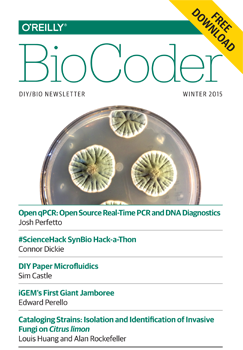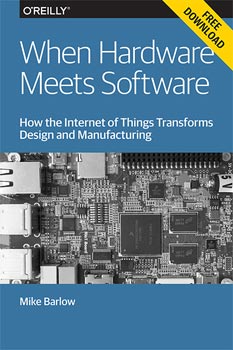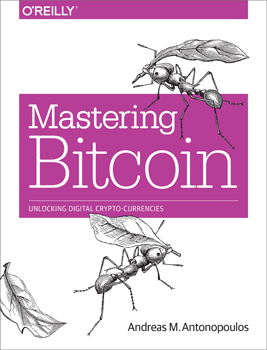Jenn Webb
Experience Design Links and Fodder: February 13, 2015
Mentor relationships; "learninghomes"; and building cross-disciplinary, collaborative teams.
Each week our design editors curate the most notable, interesting, and important material they come across. Below you’ll find their recent selections. You can get these and more in our weekly Design Newsletter.
Are you my mentor?
Digital product designer Lane Halley shares 7 Tips for Finding Your Perfect UX Mentor, and she describes how to establish a productive relationship once you’ve found one. Here’s how to bring that special someone into your life.
 Source: Cropped image by Atilla Kefeli on Flickr Read more…
Source: Cropped image by Atilla Kefeli on Flickr Read more…
More than a currency, bitcoin is an enabling technology
The O'Reilly Radar Podcast: Balaji Srinivasan on the bigger picture of bitcoin, liquid markets, and the future of regulation.
The promise of bitcoin and blockchain extends well beyond its potential disruption as a currency. In this Radar Podcast episode, Balaji Srinivasan, a general partner at Andreessen Horowitz, explains how bitcoin is an enabling technology and why it’s like the Internet, in that “bitcoin will do for value transfer what the Internet did for communication — make it programmable.” I met up with Srinivasan at our recent O’Reilly Radar Summit: Bitcoin & the Blockchain, where he was speaking — you can see his talk, and all the others from the event, in the complete video compilation now available.
The bigger picture of bitcoin
More than just a digital currency, bitcoin can serve as an instigator for new markets. Srinivasan explained the potential for everything to become a liquid market:
“Bitcoin is a platform for programmable money, programmable interchange, or anything of value. That’s very general. People have probably heard at this point about how you can use a blockchain to trade — in theory — stocks, or houses, or other kinds of things, but programmable value transfer is even bigger than just trading things which we know already exist.
“One analogy I would give is in 1988, it was not possible to find information on anything instantly. Today, most of the time it is. From your iPhone or your Android phone, you can google pretty much anything. In the same way, I think what bitcoin is going to mean, is markets in everything. That is, everything will have a price on it — everything will be a liquid market. You’ll be able to buy and sell almost anything. Where today the fixed costs of setting up such a market is too high for anything other than things that are fairly valuable, tomorrow it’ll be possible for even images or things you would not even think of normally buying and selling.”
Experience Design Links and Fodder: February 6, 2015
On-demand focus groups; the bond between ux, data, and design
Each week our design editors curate the most notable, interesting, and important material they come across. Below you’ll find their recent selections. You can get these and more in our weekly Design Newsletter.
Focus groups on demand
User experience start-up UserTesting has modernized the old-fashioned focus group: “it runs an online panel of more than one million testers…who can test products and other company materials on demand.” Current clients include the likes of Google, Facebook, Home Depot, Verizon Wireless, and Amazon — UserTesting just might be onto something.

Source: Cropped image by MCLK Travel on Flickr Read more…
Democratizing biotech research
The O'Reilly Radar Podcast: DJ Kleinbaum on lab automation, virtual lab services, and tackling the challenges of reproducibility.
The convergence of software and hardware, and the growing ubiquitousness of the Internet of Things is affecting industry across the board, and biotech labs are no exception. For this Radar Podcast episode, I chatted with DJ Kleinbaum, co-founder of Emerald Therapeutics, about lab automation, the launch of Emerald Cloud Laboratory, and the problem of reproducibility.
Kleinbaum and his co-founder Brian Frezza started Emerald Therapeutics to research cures for persistent viral infections. They didn’t set out to spin up a second company, but their efforts to automate their own lab processes proved so fruitful, they decided to launch a virtual lab-as-a-service business, Emerald Cloud Laboratory. Kleinbaum explained:
“When Brian and I started the company right out of graduate school, we had this platform anti-viral technology, which the company is still working on, but because we were two freshly minted nobody Ph.D.s, we were not going to be able to raise the traditional $20 or $30 million that platform plays raise in the biotech space.
“We knew that we had to be much more efficient with the money we were able to raise. Brian and I both have backgrounds in computer science. So, from the beginning, we were trying to automate every experiment that our scientists ran, such that every experiment was just push a button, walk away. It was all done with process automation and robotics. That way, our scientists would be able to be much more efficient than your average bench chemist or biologist at a biotech company.
“After building that system internally for three years, we looked at it and realized that every aspect of a life sciences laboratory had been encapsulated in both hardware and software, and that that was too valuable a tool to just keep internally at Emerald for our own research efforts. Around this time last year, we decided that we wanted to offer that as a service, that other scientists, companies, and researchers could use to run their experiments as well.” Read more…
A human-centered approach to data-driven design
The O'Reilly Radar Podcast: Arianna McClain on humanizing data-driven design, and Dirk Knemeyer on design in emerging tech.
This week on the O’Reilly Radar Podcast, O’Reilly’s Roger Magoulas talks with Arianna McClain, a senior hybrid design researcher at IDEO, about storytelling through data; the interdependent nature of qualitative and quantitative data; and the human-centered, data-driven design approach at IDEO.
In their interview, Magoulas noted that in our research at O’Reilly, we’ve been talking a lot about the importance of the social science design element in getting the most out of data. McClain emphasized the importance of storytelling through data at IDEO and described IDEO’s human-centered approach to data-driven design:
“IDEO really believes in staying and remaining human-centered throughout the data journey. Starting off with, how might we measure something, how might we measure a behavior. We don’t sit in a room and come up with an algorithm or come up with a question. We start by talking to people. … We’re trying to build measures and survey questions to understand at scale how people make decisions. … IDEO remains data-driven to how we analyze and synthesize our findings. When we’re given a large data set, we don’t analyze it and write a report and give it to people and say, ‘This is the direction we think you should go.’
“Instead, we look at segmentations in the data, and stories in the data, and how the data clusters. Then we go back, and we try to find people who are representative of that cluster or that segmentation. The segmentations, again, are not based on demographic variables. They are based on needs and insights that we heard in our qualitative research. … What we’ve recognized is that something that seems so clear in the analysis is often very nuanced, and it can inform our design.”
Bringing an end to synthetic biology’s semantic debate
The O'Reilly Radar Podcast: Tim Gardner on the synthetic biology landscape, lab automation, and the problem of reproducibility.
Editor’s note: this podcast is part of our investigation into synthetic biology and bioengineering. For more on these topics, download a free copy of the new edition of BioCoder, our quarterly publication covering the biological revolution. Free downloads for all past editions are also available.
Tim Gardner, founder of Riffyn, has recently been working with the Synthetic Biology Working Group of the European Commission Scientific Committees to define synthetic biology, assess the risk assessment methodologies, and then describe research areas. I caught up with Gardner for this Radar Podcast episode to talk about the synthetic biology landscape and issues in research and experimentation that he’s addressing at Riffyn.
Defining synthetic biology
Among the areas of investigation discussed at the EU’s Synthetic Biology Working Group was defining synthetic biology. The official definition reads: “SynBio is the application of science, technology and engineering to facilitate and accelerate the design, manufacture and/or modification of genetic materials in living organisms.” Gardner talked about the significance of the definition:
“The operative part there is the ‘design, manufacture, modification of genetic materials in living organisms.’ Biotechnologies that don’t involve genetic manipulation would not be considered synthetic biology, and more or less anything else that is manipulating genetic materials in living organisms is included. That’s important because it gets rid of this semantic debate of, ‘this is synthetic biology, that’s synthetic biology, this isn’t, that’s not,’ that often crops up when you have, say, a protein engineer talking to someone else who is working on gene circuits, and someone will claim the protein engineer is not a synthetic biologist because they’re not working with parts libraries or modularity or whatnot, and the boundaries between the two are almost indistinguishable from a practical standpoint. We’ve wrapped it all together and said, ‘It basically advances in the capabilities of genetic engineering. That’s what synthetic biology is.'”
Security comes from evolution, not revolution
The O'Reilly Radar Podcast: Mike Belshe on making bitcoin secure and easy enough for the mainstream.
Editor’s note: you can subscribe to the O’Reilly Radar Podcast through iTunes, SoundCloud, or directly through our podcast’s RSS feed.
In this week’s O’Reilly Radar Podcast episode, I caught up with Mike Belshe, CTO and co-founder of BitGo, a company that has developed a multi-signature wallet that works with bitcoin. Belshe talks about about the security issues addressed by multi-signature wallets, how the technology works, and the challenges in bringing cryptocurrencies mainstream. We also talk about his journey into the bitcoin world, and he chimes in on what money will look like in the future. Belshe will address the topics of security and multi-signature technology at our upcoming Bitcoin & the Blockchain Radar Summit on January 27, 2015, in San Francisco — for more on the program and registration information, visit our Bitcoin & the Blockchain website.
Multi-signature technology is exactly what it sounds like: instead of authorizing bitcoin transactions with a single signature and a single key (the traditional method), it requires multiple signatures and/or multiple machines — and any combination thereof. The concept initially was developed as a solution for malware. Belshe explains:
“I’m fully convinced that the folks who have been writing various types of malware that steal fairly trivial identity information — logins and passwords that they sell super cheap — they are retooling their viruses, their scanners, their key loggers for bitcoin. We’ve seen evidence of that over the last 12 months, for sure. Without multi-signature, if you do a bitcoin transaction on a machine that’s got any of this bad stuff on it, you’re pretty much toast. Multi-signature was my hope to fix that. What we do is make one signature happen on the server machine, one signature happen on the client machine, your home machine. That way the attacker has to actually compromise two totally different systems in order to steal your bitcoin. That’s what multi-signature is about.”
Products are now platforms
With remote connectivity and remote updates, companies are able to iterate and add value to products customers already own.
Editor’s note: this is an excerpt from our recent report, When Hardware Meets Software, by Mike Barlow. The report looks into the new hardware movement, telling its story through the people who are building it. For more stories on the evolving relationship between software and hardware, download the free report.
The Internet of Things doesn’t presage a return to the world of smoke-belching factories and floors covered with sawdust. But it does signify that change is afoot for any business or activity related to the information technology or communications industries.“Not everyone will become a hardware designer,” says Joi Ito, director of the MIT Media Lab. But many students, software engineers, and entrepreneurs will see the advantages of learning how to work with hardware. “It’s never too late to learn this stuff,” says Ito, “if you decide that you want to do it.”
At minimum, software engineers should learn as much about design and manufacturing as possible. “Buy an Arduino and start building. Everything you need to learn is on the web,” urges Jordan Husney, an avid hardware hacker who serves as strategy director at Undercurrent, an organizational transformation firm and digital think tank in lower Manhattan.
In the same way that software people will have to reconfigure their modes of thinking, hardware people will need to learn new technical skills and new ways of looking at problems, says Husney. “They will have to become more comfortable with uncertainty occurring later and later in the process,” he says. “Hardware engineers will keep things in the realm of bits (as opposed to committing them to atoms) by sharing designs using digital collaboration and simulation tools virtually, while testing multiple physical prototypes. I think we’re going to see the supply chain start to shift around these concepts.” Read more…
The data lake model is a powerhouse for invention
In this O'Reilly Radar Podcast: Edd Dumbill on the data lake, and Rajiv Maheswaran on the science of moving dots.
In a recent blog post, Edd Dumbill, VP of strategy at Silicon Valley Data Science, wrote about the phrase “data lake.” Likening it to a dream, he described a data lake as “a place with data-centered architecture, where silos are minimized, and processing happens with little friction in a scalable, distributed environment…Data itself is no longer restrained by initial schema decisions, and can be exploited more freely by the enterprise.” He explained that he called it a “dream” because “we’ve a way to go to make the vision come true” — but noted he’s optimistic the dream can be realized.
Subscribe to the O’Reilly Radar Podcast
In this Radar Podcast epidsode, O’Reilly’s Mac Slocum sits down with Dumbill to talk about the data lake, the opportunities the model presents, and the driving forces behind the concept. Read more…
Security principles of bitcoin
The core principle in bitcoin is decentralization, and it has important implications for security.
Editor’s note: this is an excerpt from Chapter 10 of our recently released book Mastering Bitcoin, by Andreas Antonopoulos. You can read the full chapter here. Antonopoulos will be speaking at our upcoming event Bitcoin & the Blockchain, January 27, 2015, in San Francisco. Find out more about the event and reserve your spot here.
Securing bitcoin is challenging because bitcoin is not an abstract reference to value, like a balance in a bank account. Bitcoin is very much like digital cash or gold. You’ve probably heard the expression “Possession is nine tenths of the law.” Well, in bitcoin, possession is ten tenths of the law. Possession of the keys to unlock the bitcoin, is equivalent to possession of cash or a chunk of precious metal. You can lose it, misplace it, have it stolen, or accidentally give the wrong amount to someone. In every one of those cases, end users would have no recourse, just as if they dropped cash on a public sidewalk.However, bitcoin has capabilities that cash, gold, and bank accounts do not. A bitcoin wallet, containing your keys, can be backed up like any file. It can be stored in multiple copies, even printed on paper for hardcopy backup. You can’t “backup” cash, gold, or bank accounts. Bitcoin is different enough from anything that has come before that we need to think about bitcoin security in a novel way too.
Security principles
The core principle in bitcoin is decentralization and it has important implications for security. A centralized model, such as a traditional bank or payment network, depends on access control and vetting to keep bad actors out of the system. By comparison, a decentralized system like bitcoin pushes the responsibility and control to the end users. Because security of the network is based on Proof-Of-Work, not access control, the network can be open and no encryption is required for bitcoin traffic. Read more…




